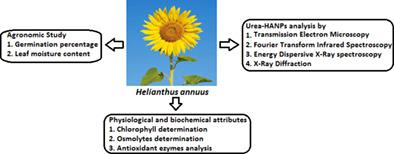当前位置:
X-MOL 学术
›
Microsc. Res. Tech.
›
论文详情
Our official English website, www.x-mol.net, welcomes your feedback! (Note: you will need to create a separate account there.)
Modulating response of sunflower (Hellianthus annuus) to induced salinity stress through application of engineered urea functionalized hydroxyapatite nanoparticles
Microscopy Research and Technique ( IF 2.5 ) Pub Date : 2021-08-09 , DOI: 10.1002/jemt.23900 Rehman Ullah 1 , Safia Sher 1 , Zahir Muhammad 1 , Saiqa Afriq Jan 1 , Muhammad Nafees 1
Microscopy Research and Technique ( IF 2.5 ) Pub Date : 2021-08-09 , DOI: 10.1002/jemt.23900 Rehman Ullah 1 , Safia Sher 1 , Zahir Muhammad 1 , Saiqa Afriq Jan 1 , Muhammad Nafees 1
Affiliation

|
Agro-nanotechnology aims to improve the quality and quantity of plants and plant products while preserving environmental health. Contemporary anecdotal studies that provide representation of the use of nanostructures as fertilizers, pesticides, and plant growth regulators have highlighted the need to determine the effect of such modified nanofertilizers on transforming plant yield under abiotic stress. Present study was performed to modulate the physiological response of Hellianthus annuus through the application of Urea capped hydroxyapatite nanoparticles (Urea-HANPs) in stressed environment. Hydroxyapatite nanoparticles were synthesized via co-precipitation method, functionalized with urea and characterized through a series of contemporary techniques of transmission electron microscopy (TEM), energy dispersive X-ray spectroscopy (EDX), X-ray diffraction (XRD), and Fourier transform infrared (FTIR) spectroscopy. We observed that Urea-HANPs significantly (p < .05) ameliorated resistivity in plant to osmotic stress by enhancing agronomic and physiobiochemical attributes. Elevated chlorophyll contents were reported from tested leaves treated with Urea-HANPs in T6 (0.05 M NaCl + 10 μg/ml Urea-HANP) under induced salinity stress. Data revealed significant decrease in osmolytes at T3 (0.1 M NaCl), and T4 (0.2 M NaCl) which was significantly ameliorated in T9 (0.1 M NaCl + 10 μg/ml Urea-HANPs) and T12 (0.2 M NaCl + 10 μg/ml Urea-HANPs). The antioxidant system was boosted up by the application of Urea-HANPs preventing the plant from oxidative stress by scavenging reactive oxygen species (ROS). It has been concluded that alleviation in impact of osmotic stress on plant through the use of Urea-HANPs was coupled with elevation in photosynthetic performance, stimulation of osmolytes and boosting antioxidant system of plants.
中文翻译:

通过应用工程尿素功能化羟基磷灰石纳米颗粒调节向日葵(Hellianthus annuus)对诱导盐胁迫的反应
农业纳米技术旨在提高植物和植物产品的质量和数量,同时保持环境健康。当代轶事研究提供了纳米结构用作肥料、杀虫剂和植物生长调节剂的代表性,强调需要确定这种改性纳米肥料在非生物胁迫下对转化植物产量的影响。本研究旨在调节向日葵的生理反应通过在压力环境中应用尿素封端的羟基磷灰石纳米颗粒 (Urea-HANPs)。通过共沉淀法合成羟基磷灰石纳米颗粒,用尿素进行功能化,并通过一系列现代技术表征,如透射电子显微镜 (TEM)、能量色散 X 射线光谱 (EDX)、X 射线衍射 (XRD) 和傅立叶变换红外(FTIR)光谱。我们观察到尿素-HANPs 显着(p < .05) 通过增强农艺和生理生化属性改善植物对渗透胁迫的抵抗力。据报道,在诱导盐分胁迫下,在 T6(0.05 M NaCl + 10 μg/ml Urea-HANP)中用尿素-HANP 处理的测试叶片的叶绿素含量升高。数据显示 T3 (0.1 M NaCl) 和 T4 (0.2 M NaCl) 的渗透物显着减少,这在 T9 (0.1 M NaCl + 10 μg/ml Urea-HANPs) 和 T12 (0.2 M NaCl + 10 μg/ ml 尿素-HANP)。应用尿素-HANPs 通过清除活性氧 (ROS) 来防止植物免受氧化应激,从而增强了抗氧化系统。已经得出结论,通过使用尿素-HANPs 减轻渗透胁迫对植物的影响与光合性能的提高相结合,
更新日期:2021-08-09
中文翻译:

通过应用工程尿素功能化羟基磷灰石纳米颗粒调节向日葵(Hellianthus annuus)对诱导盐胁迫的反应
农业纳米技术旨在提高植物和植物产品的质量和数量,同时保持环境健康。当代轶事研究提供了纳米结构用作肥料、杀虫剂和植物生长调节剂的代表性,强调需要确定这种改性纳米肥料在非生物胁迫下对转化植物产量的影响。本研究旨在调节向日葵的生理反应通过在压力环境中应用尿素封端的羟基磷灰石纳米颗粒 (Urea-HANPs)。通过共沉淀法合成羟基磷灰石纳米颗粒,用尿素进行功能化,并通过一系列现代技术表征,如透射电子显微镜 (TEM)、能量色散 X 射线光谱 (EDX)、X 射线衍射 (XRD) 和傅立叶变换红外(FTIR)光谱。我们观察到尿素-HANPs 显着(p < .05) 通过增强农艺和生理生化属性改善植物对渗透胁迫的抵抗力。据报道,在诱导盐分胁迫下,在 T6(0.05 M NaCl + 10 μg/ml Urea-HANP)中用尿素-HANP 处理的测试叶片的叶绿素含量升高。数据显示 T3 (0.1 M NaCl) 和 T4 (0.2 M NaCl) 的渗透物显着减少,这在 T9 (0.1 M NaCl + 10 μg/ml Urea-HANPs) 和 T12 (0.2 M NaCl + 10 μg/ ml 尿素-HANP)。应用尿素-HANPs 通过清除活性氧 (ROS) 来防止植物免受氧化应激,从而增强了抗氧化系统。已经得出结论,通过使用尿素-HANPs 减轻渗透胁迫对植物的影响与光合性能的提高相结合,



























 京公网安备 11010802027423号
京公网安备 11010802027423号